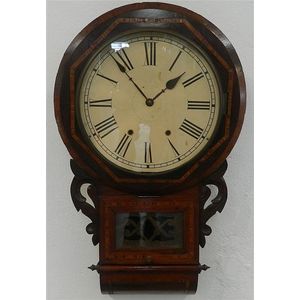1880 New Haven Clock Company Wall Clock with Restoration History
A New Haven Clock Company wall clock circa 1880 with original key & pendulum, inlaid satinwood stringing. Full restoration history.
You must be a subscriber, and be logged in to view price and dealer details.
Subscribe Now to view actual auction price for this item
When you subscribe, you have the option of setting the currency in which to display prices to $Au, $US, $NZ or Stg.
This item has been sold, and the description, image and price are for reference purposes only.
- Satinwood - Satinwood is a dense pale gold coloured timber that was imported into Britain in the second half of the 18th century, and early 19th centuries from the East Indies and the West Indies. The name derives from the satin-like surface sheen when the timber is polished.
It was used in the solid, as a veneer and in inlays. As well as furniture, satinwood was used for making musical instruments, barometers, boxes and clocks.
It will usually be found on only the very best quality objects, presumably because of of its cost at the time. - Circa - A Latin term meaning 'about', often used in the antique trade to give an approximate date for the piece, usually considered to be five years on either side of the circa year. Thus, circa 1900 means the piece was made about 1900, probably between 1895 and 1905. The expression is sometimes abbreviated to c.1900.
- Pendulum - The pendulum was discovered around 1602 by Galileo Galilei, and was adopted for time keeping by the Dutch mathematician and natural philosopher, Christiaan Huygens, who excelled in astronomy, physics, and horology.
The pendulum comprises a metal rod usually of brass or steel with a metal disk, known as a bob, at the end. The movement of the pendulum is driven by weights or a spring, and as a pendulum swings in a regular arc, it was found accuracy could be controlled to within a few seconds a week.
Timekeeping can be adjusted by changing the height of the bob on the rod, making the pendulum either swing slower or faster.
The disadvantage of the pendulum was that changes in temperature also changed the length of the pendulum, interfering with the accuracy of the clock, and so in the 18th century two types of mercurial pendulums were invented which countered the movement in the steel rod.
The pendulum was the world's most accurate timekeeping technology until the invention of the quartz clock, regulated by a quartz crystal, in 1927.
This item has been included into following indexes:
Visually similar items

A 19th century drop dial wall clock clock face replaced minute hand not working
Sold by
in
for
You can display prices in $Au, $US, $NZ or Stg.

Whitfield Breacon 19th century American wall clock, mahogany case with key and pendulum
Sold by
in
for
You can display prices in $Au, $US, $NZ or Stg.

George III mahogany drop dial wall clock by Thomas Mudge and William Dutton, London silvered dial with Roman and Arabic numerals and blued steel hands with heart shaped ends
Sold by
in
for
You can display prices in $Au, $US, $NZ or Stg.

Antique Ansonia wall clock with striking movement, 62 cm high
Sold by
in
for
You can display prices in $Au, $US, $NZ or Stg.
